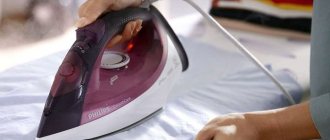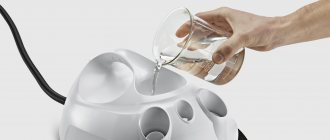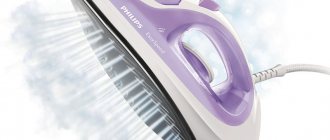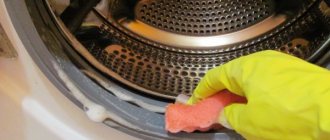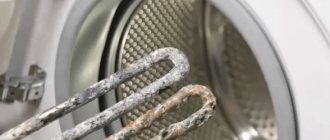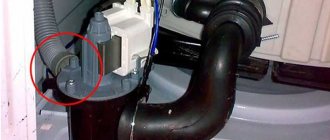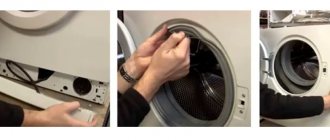The steam generator is practically indispensable in the household. This multifunctional device saves time and effort and makes life easier. With its help, you can easily iron linen and clothes, clean carpets, curtains, tiles and much more.
To prevent scale, it is recommended to pour only distilled water into steam generators. But this is not always possible. Tap water contains a large amount of salts, which lead to the formation of limescale. It can greatly spoil the quality of the equipment or even disable it. Therefore, you need to get rid of accumulated lime and carry out cleaning from time to time for prevention. This article contains tips on how to clean a steam generator from lime deposits without resorting to the services of specialists.
Types of steam heaters
Cleaning the steam generator depends on its type. There are two of them:
- Pump devices. In such steam heaters, steam is released due to the high pressure that occurs when water evaporates. Pump steam generators are convenient and easy to use. However, they are quite expensive, and their design is complex. Therefore, such devices cannot be cleaned yourself. If problems arise, please contact the service center. In addition, it is recommended to take pump steam generators for preventive inspection 1-2 times a year.
- Gravity-flow devices. In these steam heaters, steam is supplied gradually as it evaporates. Gravity-flow generators are easy to use, and you can clean them from scale using improvised means. It is recommended to clean them once a month for prevention, especially if they are used constantly.
Irons from brands such as Philips and Tefal already have a descaling function, so you don’t have to bother with them. As for other devices, you need to wash them yourself. But first, let’s figure out why we need to descale equipment at all?
Methods for descaling a steam generator
Descaling in the steam generator itself is carried out in two separate stages:
- Cleaning tanks (boilers);
- Cleaning the ironing tool (iron).
In devices with a built-in system, descaling is carried out according to the readings of a special sensor built into the design of the device. The user is reminded of the need for regular cleaning by a signal from the corresponding indicator.
In devices that do not have such a system, the need for regular cleaning is determined visually when solid particles (flakes) of scale or dirty drops are detected in the holes of the iron sole. In addition, a decrease in pressure and a decrease in the amount of steam escaping also indicates the need to descale the device.
Read about how to disassemble the steam generator of an iron here.
Why is scale dangerous?
Scale is made up of salts, calcium and magnesium. They remain in the steam heater after the water has evaporated and form lime. Limescale can seriously damage an item: it can remain on the fabric in the form of yellow stains or white flakes.
Plaque also conducts heat poorly and does not absorb it. This means that the device will heat up for a long time, spending a lot of energy, and over time it will stop working completely.
Therefore, it is so important to clean the steam heater from it in a timely manner.
Steam generators of new models have a self-shut-off function; it is triggered when there is too much scale in the device. This technique “can” self-clean, that is, to remove scale, it is enough to turn on the cleansing mode and steam a piece of unnecessary fabric. If there is no such function, an unpleasant odor and weak steam pressure indicate the need to clean the steam generator. To achieve the best results, you should clean both the inside (water tank) and the outside (sole) of the device.
Causes and consequences of scale formation
The cause of scale is an increased level of water hardness. The main substances that determine hardness are natural minerals - calcium and magnesium. The greater the amount of them contained in the water, the harder the water.
When water is heated, intermolecular bonds between water molecules and impurities dissolved in it are destroyed. The result of this chemical reaction is the formation of a sediment of solid particles of these minerals called “scale.”
Why water flows from the steam generator can be found out here.
Hard and dense scale deposits that grow over time cause premature failure of steam heaters.
Professional products
There are special products that help clean steam generators from scale. It is best to buy cleaners of the same brand as the steam heater. Some manufacturers, for example, Karcher, sell the cleaning product immediately along with the equipment. Green&Clean and Anti-scale have proven themselves well.
Important! Please read the instructions carefully before use. It tells you how to clean the steam generator without damaging the equipment.
How to clean a steam generator from scale?
Automatic descaling of the tank (boiler) is carried out in the following order:
- The remaining water is removed from the water tank through the filling hole;
- Turn the devices on their side or in another comfortable position;
- Remove the shut-off valve;
- Through the descaling hole, pour 0.5 liters of distilled water or cleaning solution into the device;
- Set the shut-off valve to its original position;
- Turn on and heat to maximum temperature;
- While holding down the steam button, test iron the unwanted fabric;
- Disconnect the device from the power supply and leave the device to cool for 2 hours;
- Remove the shut-off valve to allow the remaining water in the housing to flow out;
- Place the valve in place;
- Use a damp cloth to clean the body of the device from smudges.
Attention! During the cleaning process, a jet of hot steam together with splashes of hot and dirty water come out at high speed. Cleaning is stopped at the moment when dirty water stops coming out or clean steam starts coming out.
Cleaning the steam generator from scale, in accordance with the recommendations of household appliance manufacturers, should be done only with special means. Exposure to improvised cleaning agents, chosen independently or prepared according to folk recipes, can lead to the destruction of heating elements and internal parts of the tank body, which will lead to failure of the equipment.
Also check out: How to descale a steamer?
Vinegar
You can descale the steam generator yourself using vinegar. There are several ways to do this.
Method 1
- Pour an aqueous solution of vinegar into the boiler (1:1, no more than 25% of the total volume).
- Turn on the device at full power.
- Turn on steaming and go over the fabric several times.
- Pour distilled water and iron the fabric.
- Repeat the procedure.
Method 2
- Make a mixture of soda and vinegar (1:5).
- Pour the resulting liquid onto a cloth and wipe the surface of the steam heater.
- Rinse with warm water and wipe dry.
- Steam the unnecessary fabric.
Method 3
It is suitable for cleaning the soleplate of an iron with a steam generator. You can take not only vinegar, but also citric acid:
- Place two wooden blocks on the bottom of a deep frying pan.
- Place the iron on them with the sole down so that it does not touch the bottom of the container.
- Dilute vinegar in water (1:5) and pour it into the frying pan so that the iron goes 1-1.5 cm into it.
- Set the steam level to maximum.
- Boil the liquid in a frying pan for 1.5-2 minutes.
- Rinse the sole and dry for 24 hours.
How to prevent scale formation?
Scale formation leads to a significant reduction in the service life of steam heating units. To prevent premature failure of the device, the following preventive measures must be taken:
- use only distilled, filtered water or purchase a water neutralizer (softener) in household chemical stores;
- Clean boiler and iron tanks from scale in a timely manner using both automatic cleaning agents and improvised means.
The described methods and procedure for cleaning an iron with a steam heater from scale will ensure uninterrupted operation of the household appliance throughout its entire service life.
“With or without a boiler: which steam generator is better?” - read the article at the link.
Lemon acid
Citric acid is one of the most popular anti-scale agents.
There are several ways to clean a steam generator.
Method 1
- Dilute 1 tbsp. l. acid in 1 liter of water.
- Pour the resulting liquid into the reservoir.
- After 20 minutes, switch the device to maximum steam mode and leave it until the liquid has completely evaporated.
- Rinse the device well.
- Pour in clean water and evaporate it.
Method 2
In particularly advanced cases, you should disassemble the steam heater and clean it manually from the inside. It is recommended to use this method at least once every 2 years.
The action plan is:
- Disassemble the device with a screwdriver. This must be done carefully, preferably according to the instructions.
- Wipe off the dust with a dry cloth.
- 1 tsp. dissolve citric acid in 1 tbsp. hot boiled water.
- Seal all holes in the work surface with tape.
- Pour the solution into the boiler. An active reaction will begin and foam will flow out of the holes. It is important to ensure that it does not get on the wires and contacts, and to wipe off any excess with a sponge.
- Leave the liquid in the steam generator for half an hour.
- Drain the solution along with the removed lime.
- Rinse equipment with warm water.
- You can clean small holes and hard-to-reach places with a thin brush dipped in lemon juice solution.
- Assemble the steam generator, remove the remaining tape and iron a test waste cloth.
Instead of lemon juice, you can use any other descaling agent: Antiscale, vinegar or soap.
Important! Keep in mind that the fumes from vinegar and citric acid smell sharp and unpleasant. Therefore, during the procedure, it is recommended to open the window and turn on the hood.
Methods for cleaning the steamer soleplate
Often the cause of steam generator contamination is not only scale, but also carbon deposits on the base of the device. This problem can lead to damage to fabrics during ironing and damage to your favorite items. To avoid this, clean the surface in a timely manner using one of the methods presented.
Paraffin and salt
Cleaning procedure:
- Combine crushed paraffin with fine salt and pour onto a sheet of white paper.
- Plug in the iron and use a heated soleplate to iron the mixture until the molten substance covers the entire surface.
- Wipe the cooled iron with a soft, dry cloth.
Dishwashing liquid
To clean the surface from carbon deposits, lime flakes and stains, wipe the sole with a sponge soaked in a weak soap solution. The device should be cleaned in a cold state to prevent dirt from burning even more. After cleaning, wipe the surface with a soft cloth and you can use the ironing device for its intended purpose.
You can clean the soleplate of the iron using regular detergent and a kitchen sponge, which every housewife has in her kitchen.
other methods
The following products will help get rid of carbon deposits, rust and other marks on the soleplate of the iron:
- soda _ Combine 100 ml of distilled water (or vinegar) and 2 tsp. soda Rub the resulting paste onto the slightly heated soleplate of the iron, and then clean the surface with a soft piece of cloth;
- toothpaste . The available product will effectively clean the soleplate and steam outlets. Polish the surface with a cotton pad and toothpaste, and then wipe with a clean cloth;
- hydrogen peroxide . Soak cotton wool in a medical product and treat the surface. This product is suitable for irons with ceramic soles.
Tips for care and use
So that the steam generator does not have to be urgently rescued, there is no need to bring it to this state. Here are a few tips that you can follow to extend the life of your equipment and keep it in good shape:
- Rinse the device with clean water before and after use. Drain off the remaining liquid.
- Do not try to clean pump steam generators at home - use the services of service centers.
- Fill the device only with clean, soft water, preferably distilled or filtered.
- If finances allow, you can purchase a water softener. They are sold in household chemical departments.
- When cleaning the surface of the steam generator, do not use metal sponges or brushes.
- Harsh, abrasive products are contraindicated with Teflon and ceramic coatings.
- Salt should also not be used for cleaning.
- Always place the steam generator with its nose facing up.
- Before first use, read the instructions for use and manufacturer's recommendations.
How to remove dirt from the soleplate of an iron?
The easiest way to clean the soleplate of a Phillips steam generator is a special pencil. You can buy it for less than 100 rubles at any hardware store. To clean, run a pencil over the hot surface of the iron. At the same time, the rod melts slightly and emits a chemical smell.
When all contaminated areas are cleaned, you need to iron the unnecessary cotton cloth and turn off the device to cool.
There are other options:
- hydroperite;
- hydrogen peroxide;
- liquid laundry detergent or dishwashing detergent;
- toothpaste.
These improvised means help out when it is not possible to use a pencil. They are applied in a thin layer to the base of the steam generator. Turn the iron on at full power and begin ironing the cotton towel for a couple of minutes. When finished, the sole is washed with soapy water, rinsed and left to dry.
Important! It is strictly forbidden to use abrasives, metal brushes and brushes to clean the surface of steam generators to avoid damage.
How to use the self-cleaning function?
If the steam generator is equipped with a self-cleaning system, its service life will be much longer than without it. Before starting work, you must carefully study the operating instructions, because each system has its own characteristics:
- “Anti calc” – an anti-calc rod is installed on the steam switch, which purifies the water by retaining magnesium and calcium salts;
- “Self clean” - the system is located between the tank and the pump, its installation requires a self-cleaning filter;
- “Calc clean” – the self-cleaning function is launched by pressing a special button installed on the steam generator.
How to properly use the “Self clean” and “Calc clean” options:
Purified or distilled water is poured into the steam generator tank.- Set the maximum temperature on the display and connect the device to the network.
- Wait until the water is completely heated.
- Hold the steam generator over the sink, shake it periodically and press the self-cleaning button.
- The above steps are carried out 2 times.
If the device has a filter, clean it separately by soaking it in vinegar for 30-40 minutes , then rinse under running water.
Some models have filter cartridges located in special compartments. To replace a used cartridge, just:
- open the compartment;
- remove the old filter;
- install a new cartridge;
- close the compartment cover.
Rules for using the Anti calc system:
- Remove the rod from the device.
- In a glass of water, stir 1 tablespoon of vinegar and 1 dessert spoon of citric acid.
- Immerse the rod in the acid solution for 15-20 minutes.
- Rinse under the tap.
- Install the rod into the apparatus.
If you ignore the self-cleaning function and do not use it, the device will quickly fail. If you regularly use the steam generator, the self-cleaning system must be turned on every 2 weeks.
Cleaning the sole
You need to take comprehensive care of the steam generator - after internal cleaning, remove carbon deposits from the soleplate of the iron . To do this, make a paste of soda, toothpaste, vinegar, water and gently wipe the surface with a flannel or woolen rag.
The contaminated surface can be cleaned with window cleaning liquid; burnt synthetics can be removed with acetone.
To avoid damaging the smooth surface, the following cleaning is recommended:
Teflon - slightly heated, rubbed with laundry soap, remove carbon deposits with a toothpick;- ceramic - wipe with a cotton pad soaked in hydrogen peroxide;
- made of stainless steel - cleaned with a mixture of paraffin and fine salt;
- The non-stick coating is cleaned with a solution of ammonia and water 1:10.
All other surfaces are wiped with a 1:3 solution of liquid soap and water, and the remaining carbon deposits are scraped off with a wooden stick.
How to cleanse using traditional methods?
Housewives often use improvised means to get rid of limestone deposits. This is especially true if the layer is not too hard and thick, and there is no opportunity to buy substances specifically designed for removal.
Traditional methods of cleaning an iron may involve not only removing scale from the inside, but also treating the sole externally. The key advantage of using improvised means is their low price and availability: such substances are found in most homes.
How to remove with vinegar?
This is an inexpensive substance that copes with medium and low density scale. Due to the low concentration of acid in the composition, it is allowed to use the product in its pure form. It is poured into the water hole, the iron is heated and the equipment is left on for a quarter of an hour. Then the device is unplugged from the outlet and waited for 2 hours without draining the contents. After this, the tank is rinsed a couple of times to completely remove any residue.
For cleaning, you can also take acetic acid, but it cannot be used in its pure form: vinegar is mixed with clean water. The proportions depend on the concentration of the active substance. If the procedure does not completely remove traces of plaque, it is repeated, but in most cases it is possible to cope with the problem on the first try.
Remove scale with citric acid
This is another popular method, which is accessible and relatively easy. To clean the internal parts of the iron with citric acid, you will need to dissolve 25-30 g of the substance in boiled or filtered water, then pour it into the device’s reservoir. The device is warmed up, placed vertically and left in this position for 10-15 minutes.
Before draining, you need to prepare a bucket or basin for the waste liquid. Draining is performed by pressing the steam adjustment button. Water containing plaque particles will flow out of the steam holes on the soleplate. When the liquid becomes clear, it means that the citric acid has completely removed calcium deposits.
Why is cleaning necessary?
The quality of water in modern pipelines is far from ideal . It contains calcareous compounds and salt, which, when heated, can leave traces of scale in the steam generator tank.
Steam is not able to break through thick limescale, which impairs the operation of the device, leaving dark streaks and lime flakes on the material during ironing.
Cleaning methods are selected individually for each device model, which come in two types:
Pump-action. Steam under pressure comes out in a powerful stream when you press a button. The pump steam generator irons things perfectly, but it is difficult to clean it yourself.
The mechanism of the pump device is vulnerable; improper handling can lead to damage to the device, so it is better to contact a service center to resolve the problems. Gravity flow. The movement of steam does not need to be controlled - as it evaporates from the tank, it constantly flows to the fabric. An excellent machine for ironing small amounts of laundry.
The gravity steam generator is not capricious; it can be cleaned independently, without the involvement of professional help.
Recommendations
To ensure that your iron serves you as long as possible, use ONLY purified water in it:
- distilled;
- demineralized;
- from a reverse osmosis filter;
- tap water using water softeners (for irons).
Despite the fact that manufacturers boldly claim that built-in self-cleaning filters will cope with hard water, this is not entirely true. The filters will last for the entire warranty period, but after that a breakdown may occur. The health of your device is in your hands. Take care of it, and the iron will please you for a long time.
The steam generator is practically indispensable in the household. This multifunctional device saves time and effort and makes life easier. With its help, you can easily iron linen and clothes, clean carpets, curtains, tiles and much more.
To prevent scale, it is recommended to pour only distilled water into steam generators. But this is not always possible. Tap water contains a large amount of salts, which lead to the formation of limescale. It can greatly spoil the quality of the equipment or even disable it.
Recommendations for operating and cleaning Philips steam generators from scale:
Do not fill the device with tap water. It must be passed through a filter that reduces the amount of salts.
Scale will not form if you use distilled water.
- After using the iron, the water must be drained.
- When cleaning the device, be careful not to burn yourself.
- It is necessary to drain the water from the steam generator only when the device has completely cooled down.
- If after descaling the equipment does not steam, it must be taken to a service center.
How not to clean the inside of a steam generator
It is prohibited to use the following to remove deposits:
We recommend:
How to iron a long sleeve shirt correctly
- concentrated products: may corrode or damage parts made from materials sensitive to chemical reagents;
- sulfuric, hydrochloric acid;
- acetic acid, essence;
- sweet carbonated drinks (Sprite, Coca-Cola, Fanta).
Mechanical descaling is unacceptable. If you try to scrape off deposits with sharp objects, you can damage the parts of the steam generator.
How to remove lime deposits inside?
All types of gravity models can be cleaned at home using improvised means by following these steps:
disconnect the steam generator from the network, drain the water from the boiler;- open the valve, pour the selected descaling agent into the tank;
- close the valve, set the maximum heating, turn on the device;
- iron the unnecessary fabric until clean steam comes out of the steam generator;
- disconnect the device from the network, drain the remaining water, rinse the tank with clean water, close the valve;
- Wipe the device dry and, if necessary, clean the soleplate of the iron.
Folk remedies for cleaning
In order not to spend money on industrial products, you can clean the device in several ways, using environmentally friendly and inexpensive ingredients.
Vinegar based solution
The working solution is prepared based on vinegar with a concentration of at least 9%:
- mix vinegar with purified water 1:1;
- fill the boiler with cold solution for 10-15 minutes;
- turn on heating to maximum power;
- iron the fabric until the liquid evaporates.
This method cannot be used frequently, because acetic acid has an aggressive effect on the plastic and rubber parts of the device and can damage them.
Citric acid
Dissolve 15-20 grams of citric acid (1 heaped teaspoon) in a glass of water:
- the cold solution is poured into the container for 15-25 minutes;
- turn on the steam function at the maximum temperature;
- during evaporation, iron the canvas so that the exfoliated soot flakes settle on it;
- pour purified water and turn on the heating.
Additional methods
There are many other cleaning methods that can be used at home; They are generally effective in removing thin layers of deposits.
With self-cleaning function
Many modern iron models are equipped with this option. You will need to fill the device container with filtered water, plug it in and set the maximum temperature. The device should operate until the indicator on the panel goes out, after which you can drain the liquid by pressing the Self Clean button. If you do this treatment regularly, you won’t have to repeat the cycle several times.
Citramon tablets
This medicine contains acetylsalicylic acid, which works well against scale. You will need to crush the package of citramone, pour a glass of warm water, fill the iron reservoir and plug it in for 15 minutes. After draining the liquid, the container should be rinsed with clean water.
Carbonated drinks
For example, Coca-Cola is suitable for this; the main condition is that the gas bubbles must completely evaporate before pouring into the device. After refueling, connect the iron to the mains, wait 10-12 minutes, then pour out the soda and rinse the container twice. If the deposits are not completely dissolved, you can repeat the procedure, leaving the iron turned off for 4-5 hours.
Using mineral water
The method is used if the plaque is still thin. The mineral water is poured into the tank, boiled for 10-15 minutes, then drained. Subsequent washing will need to be done 1-2 times depending on the result.
Apple peelings
If it is not possible to clean your equipment using the usual methods, you can use peeling 1-2 apples. They are filled with water, boiled, and the resulting liquid is allowed to settle. When it cools down, it is filtered, poured into an iron and heated. After 10 minutes, the liquid is drained and the tank is rinsed 1-2 times.
Ascorbic acid
A tablespoon of powder needs to be diluted in a cup of water; if the substance is available in tablets, you will need 4 pieces. The solution is poured into the tank, heated for 20 minutes, and after draining, washed with water.
Preserved brine
Lime is destroyed under the influence of an acidic environment, so to remove plaque you can use the brine left over from cucumbers or tomatoes. It is filled into the inner container, the iron is heated, after 20 minutes it is turned off and the liquid is drained. The tank is flushed at least twice.
Milk serum
Fermented milk products, for example, sour whey, are considered to be quite effective remedies for minor deposits. It is filtered through a sieve, poured into the iron container, the heat is turned on at full power and left for 15 minutes. Washing is enough to do once.
succinic acid
The product is dissolved in a proportion of 6 tablets per glass of water, the tank is filled and the iron is heated for 10 minutes. Rinsing the cleaned container is done twice, using boiled or filtered water. This option is good for removing small and medium amounts of scale.
Antiscale
The substance can be purchased at most hardware stores. The powder is dissolved in water, then used to clean the iron externally or internally. Usually 1 teaspoon of product is used per glass of water. Details on use can be found in the instructions. If the plaque has not completely disappeared, the process is repeated.
Liquid Topper
This is a modern substance that copes with any deposits, regardless of the density and thickness of the layer. The solution is diluted with clean water in the proportions specified in the instructions, then poured into a steam generator or, after wetting a rag, wipe the sole.
In case of internal cleaning, the iron will need to be heated to maximum, turned off and left for 2 hours. Afterwards it is heated again, the remaining water and steam are released, having previously been disconnected from the power supply. When wiping the sole, you must use gloves and a mask to avoid harm to the respiratory system and skin.
Iron cleaning pencil
It is a solid rod that is easy to operate. It contains acids and ureas. To remove the limescale layer, the device must be heated, then begin processing the sole part. Under the influence of elevated temperature, the pencil melts; acids weaken the crystal lattice of the scale, helping to easily remove it.
Dust mites – will it remove them?
A device such as a steam cleaner is a very important thing, especially for people suffering from allergies. Indeed, today, according to statistics, every 5 people suffer from allergies and half of them are small children. Dust mites are often the cause of an allergic reaction. By cleaning the apartment with a steam cleaner, we destroy dust mites and other allergens invisible to the eye and thereby make life easier for allergy sufferers. At the same time, steam cleaning also removes unpleasant odors and humidifies the air in the room. After it you can breathe much easier.
A large number of harmful microorganisms live on soft toys. Therefore, for the benefit of our children, such toys simply need to be steamed regularly. Steam cleaners help to destroy all these health pests.
How is a steam cleaner iron different from a regular steam boost iron?
Any surface that is not afraid of high temperatures can be exposed to steam. And in an apartment you can’t count such surfaces: stove, burners, oven, microwave, extractor hood, refrigerator, sink, tiles, joints between tiles, plumbing fixtures, bathroom and toilet, radiator, radiators, windows, mirrors, glass coffee table.
With a steam cleaner, the housewife will spend significantly less time cleaning these objects. In addition, the steam generator is capable of washing almost any floor, except waxed parquet (exposure to hot steam will lead to deformation of the wax). Nowadays, many people, having suffered from cleaning carpets, are switching to parquet or laminate flooring, which requires wet cleaning.
The steam cleaner comes with many more attachments. Burners, handles, taps, seams between tiles, radiators, baseboards are washed with a nozzle with a round brush.
A wider nozzle is suitable, for example, for washing shower stalls, stoves, doors, and kitchen cabinet doors. The kit even includes microfiber wipes. When the surface is treated with steam, the dirt lags behind and transfers to such a napkin. By the way, these napkins are very easy to wash in the washing machine.
We invite you to familiarize yourself with silverfish in the apartment. Who are they and how to fight? | Peekaboo
Many people ask this question before purchasing a steam cleaner. The answer is simple. Surfaces that can be deformed under the influence of high temperatures should absolutely not be cleaned with a steam cleaner. First of all, this is, of course, parquet covered with wax. Textiles are products made from natural wool and linen.
But for those who are afraid of excessively moistening surfaces, a solution has nevertheless been found. You just need to set the steam cleaner to a lower steam level and you can start cleaning. If you have to wash parquet or laminate, it is best to choose the minimum level.
Also, this device cannot be used to clean electrical appliances and soft plastic products.
Ironing is an additional bonus that a steam cleaner equipped with an iron provides to its owners. The steam generated by the steam generator enters the iron through a practical hose and from there it hits the fabric under high pressure. Moreover, the effect of steam is so strong that you will not need to iron your clothes from several sides.
The indisputable advantage of a steam iron over a regular iron is that it acts on the fabric not with a hot steel sole, but, as already mentioned, with steam. It creates an air cushion between the sole and the textile, which protects delicate fabrics (velvet, silk, guipure) from damage.
Also, with a steam iron, housewives will need much less time ironing. Unlike the traditional version, the steam iron does not need to be refilled with water as often. After all, the steam cleaner from which steam comes into it can hold up to approximately 3 liters of water. This, in turn, should be enough to iron a mountain of things.
Another important fact that you need to know about a steam cleaner is that it will never replace a vacuum cleaner. This device does not suck up dirt. It will not be able to collect large dirt like a vacuum cleaner or broom. Using a steam generator, you can remove stains, remove plaque and remove dust, hair and fur from the surface being cleaned.
However, the Karcher company, taking care of the comfort of its customers, offers an even more modern and advanced device - a combination of a steam cleaner and a vacuum cleaner - a steam vacuum cleaner. This miracle technique combines 3 operating modes: steam cleaner mode, regular vacuum cleaner mode and steam vacuum cleaner mode. In the latter case, it releases steam, liquefies contaminants and sucks them inside. In this mode, you can clean the floor, carpet, stove, oven, microwave, and hood.
Using tap water will cause scale to form on the boiler of the steam cleaner over time. To get rid of scale, the steamer and other attachments come with special anti-scale sticks that dissolve in cold water. These sticks are absolutely harmless to human health and the environment. The frequency of descaling of the steam cleaner depends on the hardness of the water. On average, the device is cleaned once or twice a year.
In 2015, Karcher introduced two new models of steam cleaners (SC 3 and SC 3 Premium), which do not have a heating boiler. In them, water is converted into steam using a flow-through heater. To maintain the functionality of such units for many years and protect the heating element from scale, these models use special cartridges rather than anti-scale.
According to experts, a person spends about 5 years of his life cleaning. A steam cleaner allows you to speed up the cleaning process. This device strives to solve all the issues of maintaining cleanliness and order in our apartments and houses. Thanks to him, we have more free time to spend with family and friends.
The main thing is that we do not use any chemicals during the cleaning process. Therefore, it does not remain on the surface, and neither we nor our children breathe it. Steam treatment will cope with all the problems on the way to cleaning.
Steam cleaner can be selected
How to descale steam generators at home? You just need to use one of the quite accessible means, among which the following are especially effective:
- Products that prevent the appearance of scale can be found on store shelves; they are quite easy to use; they need to be poured into a liquid reservoir, and then use the unit for its intended purpose.
- Citric acid or ordinary vinegar can prevent or get rid of scale. You need to use them like this: pour one of these substances into the tank to a third of the volume, steam any fabric, be sure to open a window for ventilation, since vinegar will emit a strong odor when heated, repeat this procedure as necessary.
- The steam generator can be easily cleaned with liquid soap, it should be used as follows: first mix water and liquid soap, taking three parts water and one part soap, with the resulting mixture you need to wipe the sole of the unit, if it does not help to cope with traces of burnt fabric, you can additionally try to scrape them off with using a toothpick. It is worth noting that this method is not suitable for Teflon surfaces.
- If scale or rust appears on the surface of your household appliances, you can use soda to remove it: mix 2 teaspoons of soda and 100 ml of water or vinegar; wipe the heated coating of the iron with this composition; Finally, clean the surface with a cloth.
- If the steam generator has a Teflon coating, it can be cleaned by heating it to a minimum and wiping it with laundry soap. The latter will melt and make the carbon deposits softer, after which it can be easily scraped off with improvised means.
- White toothpaste can act as a “scrub” that will clean the surface of the iron, after which you need to apply steam to clean the holes in the soleplate.
- A ceramic iron can be cleaned with a cotton pad soaked in hydrogen peroxide, and all holes can be thoroughly cleaned with a cotton swab.
If the steam generator coating is made of stainless steel, it can be cleaned with paraffin and salt:
- first grind a small white candle;
- then mix it with finely ground salt;
- Gently mix both ingredients and pour the resulting mixture onto a sheet of paper;
- heat the iron and iron the sheet with it;
- the paste that results from melting this substance will cover the sole of the unit;
- when the iron has cooled down, it needs to be wiped with a dry cloth;
- Finally, steam the fabric until the liquid in the tank runs out.
We suggest you familiarize yourself with Dishwasher Care: how to clean and rinse the drain system at home
It is quite unpleasant when a steam generator stops performing its functions well due to such a trivial reason as limescale.
If the steam generator is equipped with a self-cleaning function, then the system will independently notify the owner about the need for cleaning and carry out all the necessary actions to clean the iron from lime at the press of a button. This is due to the presence of a special anti-lime rod inside.
Lemon acid
- empty the steam generator of liquid;
- dilute 2 tablespoons of citric acid in a glass of warm water, previously boiled;
- pour this composition into the tank;
- heat the iron and turn on the steam;
- Now you can disconnect the device from the network and remove the product from the tank;
- For optimal effect, this procedure can be repeated occasionally.
Ordinary vinegar allows you to figure out how to clean not only the tank from the deposits that have formed, but also the soleplate from carbon deposits, making the iron with the steaming function completely new:
- prepare a frying pan, at the bottom of which you need to place two parallel wooden sticks;
- Place the switched-off iron on this base, making sure that its sole does not touch the bottom of the pan;
- prepare the composition, for this you need to dilute a glass of 9% vinegar in a liter of water or 5 tablespoons of citric acid in the same amount of water;
- pour the mixture into the frying pan, making sure that the lower part of the iron is hidden by 1.5-2 centimeters of liquid;
- set the steam regulator to the maximum position;
- heat the pan and bring the mixture to a boil;
- the liquid should boil for 2 minutes, after which you need to turn off the burner;
- You can repeat this process 2-3 times;
- in conclusion, you need to wash the sole of the steam generator under the tap and press the steam button several times;
- Allow the equipment to dry thoroughly within 24 hours, and then you can use the device again for its intended purpose.
Lemon acid
| Kinds | Description | pros | Minuses |
| Pump-action | Steam is supplied under high pressure after pressing the button. | Efficient and easy to use. | Complex design, high cost, descaling is possible only at a service center. |
| Gravity | Steam is supplied gradually as the liquid evaporates. | Easy to maintain, the design makes it easy to deal with scale yourself, affordable price. | Not as effective as pump action. |
Features of care for different brands
Many models of Tefal steam generators are equipped with a built-in self-cleaning system. This fact must be indicated in the technical description. Their cost is slightly higher than usual, but to clean it, just heat the device, press and hold a special button for 2 seconds.
Then you should wait until scale particles stop flying out along with the steam. It is better to do this procedure over a sink. If necessary, the operation can be repeated until the desired result is achieved.
